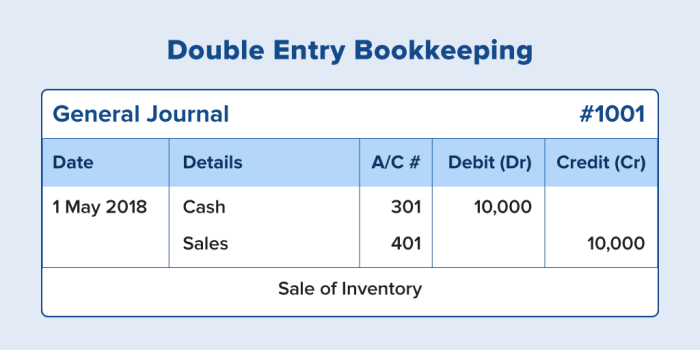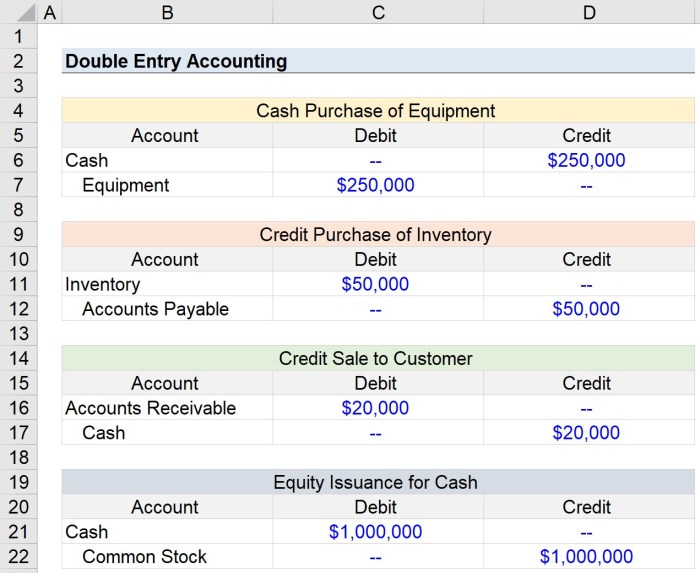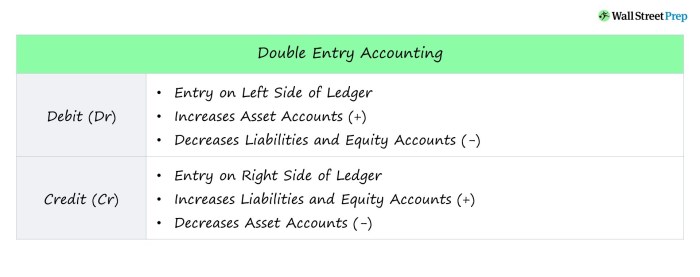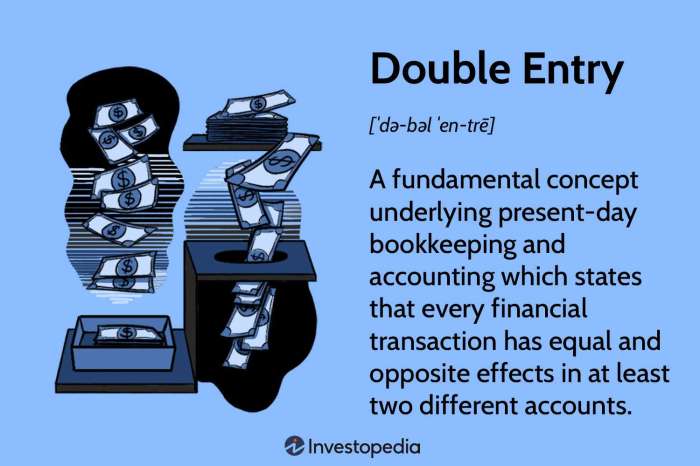The double-entry accounting system records each transaction twice. – The double-entry accounting system, a cornerstone of financial recording, stands out for its meticulous approach of documenting every transaction twice. This practice, deeply rooted in the principles of debit and credit, ensures the preservation of balance and the integrity of financial data.
As we delve into the intricacies of this system, we uncover its significance in maintaining accurate records and generating reliable financial statements.
The process of recording transactions in a double-entry system involves assigning debits to one account and corresponding credits to another. This ensures that the total debits always equal the total credits, maintaining the fundamental accounting equation of Assets = Liabilities + Equity.
Through this mechanism, the system provides a comprehensive and auditable trail of financial activities.
Double-Entry Accounting System Basics

The double-entry accounting system is a method of recording financial transactions that involves entering each transaction twice: once as a debit and once as a credit. This ensures that the total debits always equal the total credits, maintaining the accounting equation of Assets = Liabilities + Owner’s Equity.
The principles of debit and credit are fundamental to double-entry accounting. Debits increase asset and expense accounts while decreasing liability, equity, and revenue accounts. Credits, on the other hand, increase liability, equity, and revenue accounts while decreasing asset and expense accounts.
Examples of double-entry transactions include:
- Purchasing inventory for cash: Debit Inventory, Credit Cash
- Selling inventory on account: Debit Accounts Receivable, Credit Sales Revenue
- Paying salaries to employees: Debit Salaries Expense, Credit Cash
Transaction Recording

In a double-entry system, transactions are recorded in a journal, which is a chronological record of all financial events. Each transaction is entered with a debit and a credit to maintain balance.
For example, if a company purchases inventory for $1,000 on account, the following journal entry would be made:
| Account | Debit | Credit |
|---|---|---|
| Inventory | 1,000 | |
| Accounts Payable | 1,000 |
Account Balances

Account balances are the cumulative sum of all debits and credits posted to an account. Debit balances exist in asset and expense accounts, while credit balances exist in liability, equity, and revenue accounts.
Examples of account balances after various transactions:
- Cash account with a debit balance: $5,000
- Accounts Payable account with a credit balance: $2,000
- Sales Revenue account with a credit balance: $10,000
Financial Statements

Double-entry accounting data is used to create financial statements, including the balance sheet, income statement, and statement of cash flows. These statements provide a comprehensive overview of a company’s financial performance and position.
For example, the balance sheet shows the company’s assets, liabilities, and equity at a specific point in time. The income statement reports the company’s revenues, expenses, and net income over a period of time. Transactions affect financial statements by updating the account balances used to create the statements.
Advantages and Disadvantages: The Double-entry Accounting System Records Each Transaction Twice.
Advantages of using a double-entry accounting system:
- Ensures accuracy and completeness of financial records
- Provides a clear audit trail
- Facilitates the preparation of financial statements
Disadvantages of using a double-entry accounting system:
- Can be more complex and time-consuming than other accounting methods
- Requires a higher level of accounting knowledge
- Can be prone to errors if not properly maintained
Question Bank
What are the key principles of double-entry accounting?
The double-entry accounting system is founded on the principles of debit and credit. Every transaction involves a debit to one account and a corresponding credit to another, ensuring that the total debits always equal the total credits.
How does the double-entry accounting system help prevent errors?
By requiring that every transaction be recorded twice, the double-entry accounting system provides an inherent check and balance. If the total debits do not equal the total credits, an error has likely occurred, making it easier to identify and correct.
What are the advantages of using a double-entry accounting system?
The double-entry accounting system offers numerous advantages, including improved accuracy, enhanced error detection, support for informed decision-making, and compliance with regulatory requirements.